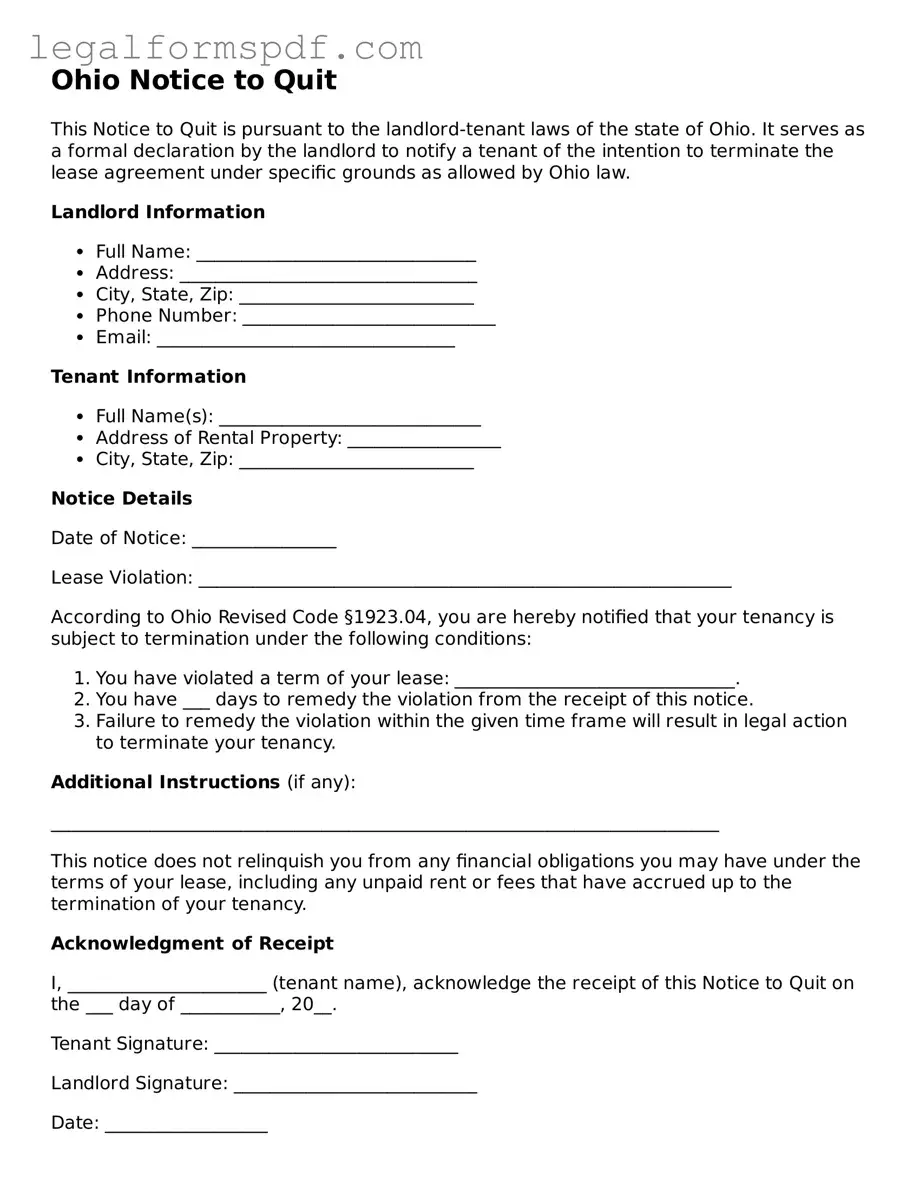The Ohio Notice to Quit form is closely related to the Pay or Quit Notice commonly used in many jurisdictions. This document similarly provides tenants with a final opportunity to rectify an issue, such as unpaid rent, before legal action is taken to evict them. Both serve as a preliminary step before more drastic measures are undertaken and are designed to give tenants a clear warning and an opportunity to remedy the situation, hence maintaining the sanctity of the lease agreement.
Another similar document is the Cure or Quit Notice. This variation requires tenants not only to address unpaid rent but also to rectify any other lease violations, such as property damage or unauthorized occupants. Like the Ohio Notice to Quit, it provides a specific timeframe for compliance, failing which the eviction process may commence. It's a broader tool, incorporating aspects of behavior correction in addition to financial compliance.
The Unconditional Quit Notice, contrasting somewhat with the Ohio Notice to Quit, demands the tenant vacate the premises without offering an opportunity to remedy the violation. Used in more severe cases, such as repeated violations or significant damage, it reflects the serious nature of the tenant's breach. Although more severe, it similarly initiates the process to reclaim property in violation of lease terms.
Eviction Notices, a more generic term that encompasses the Ohio Notice to Quit, are employed widely across various jurisdictions to inform tenants of pending legal action due to lease breaches. An Eviction Notice typically outlines the reasons for eviction, any remedial actions required, if applicable, and the timeline for vacating the property, underpinning the legal framework for lease enforcement.
Lease Termination Letters also share similarities to the Ohio Notice to Quit, especially in scenarios where either party wishes to end the rental agreement. This document can be initiated by landlords or tenants, specifying the conditions under which the lease will end ahead of schedule. Despite its broader applicability, it upholds the principle of formal notification in property management contexts.
The 30-Day Notice to Vacate serves a similar purpose to the Ohio Notice to Quit, particularly in providing a timeframe for action. This document is typically used by tenants informing landlords of their intention to leave or by landlords to advise tenants of lease non-renewal. It stresses the importance of advance notification in maintaining orderly transitions between tenants.
The 3-Day Notice to Pay or Vacate, much like its Ohio counterpart, is specifically tailored to address situations of unpaid rent, requiring tenants to either settle their debts or vacate the property within a limited period. This document demonstrates the legal balance between protecting landlord interests and offering tenants a chance to uphold their lease obligations.
The Notice of Lease Violation shares a foundational link with the Ohio Notice to Quit by focusing on breaches other than non-payment, such as unauthorized pets or guests. It informs tenants of specific lease terms that have been violated and often provides a corrective action period, underscoring the importance of adhering to agreed-upon terms within the rental agreement.
The Rent Increase Notice, while distinct in its purpose of adjusting rental terms rather than addressing lease violations, connects with the Ohio Notice to Quit through its formal notification process. It informs tenants of upcoming changes to rent payments, requiring acknowledgment or negotiation if disagreements arise, emphasizing the critical nature of communication between landlords and tenants.
Last, the Immediate Notice to Quit stands out by allowing landlords to demand tenant departure without providing a remedy period, typically reserved for egregious violations. Although it significantly differs in tenant opportunities for remediation, it parallels the Ohio Notice to Quit in its function to expedite property reclamation under severe circumstances, reinforcing landlord rights in extreme situations.
